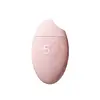What's inside
What's inside
 Key Ingredients
Key Ingredients

 Benefits
Benefits

 Concerns
Concerns

 Ingredients Side-by-side
Ingredients Side-by-side

Water
Skin ConditioningEthylhexyl Methoxycinnamate
UV AbsorberOctocrylene
UV AbsorberButyl Methoxydibenzoylmethane
UV AbsorberBis-Ethylhexyloxyphenol Methoxyphenyl Triazine
Skin ConditioningTitanium Dioxide
Cosmetic ColorantZinc Oxide
Cosmetic ColorantBifida Ferment Lysate
Skin ConditioningNiacinamide
SmoothingPentylene Glycol
Skin ConditioningGlycerin
HumectantPhenoxyethanol
PreservativeEthylhexylglycerin
Skin ConditioningButylene Glycol
HumectantCentella Asiatica Leaf Extract
Skin ConditioningPolygonum Cuspidatum Root Extract
AntioxidantScutellaria Baicalensis Root Extract
AstringentCamellia Sinensis Leaf Extract
AntimicrobialGlycyrrhiza Glabra Root Extract
BleachingChamomilla Recutita Flower Extract
MaskingRosmarinus Officinalis Leaf Extract
AntimicrobialSodium Polyacrylate
AbsorbentCaprylic/Capric Triglyceride
MaskingParaffinum Liquidum
EmollientTri-PPG-3 Myristyl Ether Citrate
Skin ConditioningSorbitan Laurate
EmulsifyingTrideceth-6
EmulsifyingMagnolia Kobus Bark Extract
Skin ConditioningCaprylic/Capric/Succinic Triglyceride
EmollientWater, Ethylhexyl Methoxycinnamate, Octocrylene, Butyl Methoxydibenzoylmethane, Bis-Ethylhexyloxyphenol Methoxyphenyl Triazine, Titanium Dioxide, Zinc Oxide, Bifida Ferment Lysate, Niacinamide, Pentylene Glycol, Glycerin, Phenoxyethanol, Ethylhexylglycerin, Butylene Glycol, Centella Asiatica Leaf Extract, Polygonum Cuspidatum Root Extract, Scutellaria Baicalensis Root Extract, Camellia Sinensis Leaf Extract, Glycyrrhiza Glabra Root Extract, Chamomilla Recutita Flower Extract, Rosmarinus Officinalis Leaf Extract, Sodium Polyacrylate, Caprylic/Capric Triglyceride, Paraffinum Liquidum, Tri-PPG-3 Myristyl Ether Citrate, Sorbitan Laurate, Trideceth-6, Magnolia Kobus Bark Extract, Caprylic/Capric/Succinic Triglyceride
Water
Skin ConditioningEthylhexyl Methoxycinnamate
UV AbsorberMethylene Bis-Benzotriazolyl Tetramethylbutylphenol
UV FilterDecyl Glucoside
CleansingPropylene Glycol
HumectantXanthan Gum
EmulsifyingButyl Methoxydibenzoylmethane
UV AbsorberHydroxyethyl Acrylate/Sodium Acryloyldimethyl Taurate Copolymer
Emulsion StabilisingSaccharide Isomerate
HumectantC15-19 Alkane
SolventCyclopentasiloxane
EmollientDimethicone
EmollientIsohexadecane
EmollientPolysorbate 60
EmulsifyingOctyldodecanol
EmollientOctyldodecyl Xyloside
EmulsifyingPEG-30 Dipolyhydroxystearate
EmulsifyingPhenoxyethanol
PreservativeSolanum Lycopersicum Fruit Extract
AntioxidantParfum
MaskingEDTA
Citric Acid
BufferingSodium Hyaluronate
HumectantWater, Ethylhexyl Methoxycinnamate, Methylene Bis-Benzotriazolyl Tetramethylbutylphenol, Decyl Glucoside, Propylene Glycol, Xanthan Gum, Butyl Methoxydibenzoylmethane, Hydroxyethyl Acrylate/Sodium Acryloyldimethyl Taurate Copolymer, Saccharide Isomerate, C15-19 Alkane, Cyclopentasiloxane, Dimethicone, Isohexadecane, Polysorbate 60, Octyldodecanol, Octyldodecyl Xyloside, PEG-30 Dipolyhydroxystearate, Phenoxyethanol, Solanum Lycopersicum Fruit Extract, Parfum, EDTA, Citric Acid, Sodium Hyaluronate
 Reviews
Reviews

Ingredients Explained
These ingredients are found in both products.
Ingredients higher up in an ingredient list are typically present in a larger amount.
Also known as Avobenzone, this ingredient is a chemical sunscreen filter that provides protection in the UV-A range.
Avobenzone is globally approved and is the most commonly used UV-A filter in the world.
Studies have found that avobenzone becomes ineffective when exposed to UV light (it is not photostable; meaning that it breaks down in sunlight). Because of this, formulations that include avobenzone will usually contain stabilizers such as octocrylene.
However, some modern formulations (looking at you, EU!) are able to stabilize avobenzone by coating the molecules.
Avobenzone does not protect against the UV-B range, so it's important to check that the sunscreen you're using contains other UV filters that do!
The highest concentration of avobenzone permitted is 3% in the US, and 5% in the EU.
Learn more about Butyl MethoxydibenzoylmethaneEthylhexyl Methoxycinnamate is an organic compound that provides UVB protection. It often goes by the more common name of octinoxate. It is created from methoxycinnamic acid and 2-ethylhexanol.
Ethylhexyl Methoxycinnamate absorbs UVB rays with wavelengths between 280-320 nm. UV absorbers protect your skin by using chemical reactions to convert UV rays into heat and energy.
UVB (290-320 nm) rays emit more energy than UVA rays. They are capable of damaging DNA, causing sunburns and are thought to be linked to skin cancer.
The state of Hawaii has banned sunscreens containing octinoxate due to its potential impact on coral reefs. More research is needed to bridge gaps in this research. The European Union allows higher levels of octinoxate in sunscreens than the US and Australia.
Ethylhexyl Methoxycinnamate is oil soluble. It is not stable and may lose efficacy when exposed to sunlight.
Learn more about Ethylhexyl MethoxycinnamatePhenoxyethanol is a preservative that has germicide, antimicrobial, and aromatic properties. Studies show that phenoxyethanol can prevent microbial growth. By itself, it has a scent that is similar to that of a rose.
It's often used in formulations along with Caprylyl Glycol to preserve the shelf life of products.
Water. It's the most common cosmetic ingredient of all. You'll usually see it at the top of ingredient lists, meaning that it makes up the largest part of the product.
So why is it so popular? Water most often acts as a solvent - this means that it helps dissolve other ingredients into the formulation.
You'll also recognize water as that liquid we all need to stay alive. If you see this, drink a glass of water. Stay hydrated!
Learn more about Water